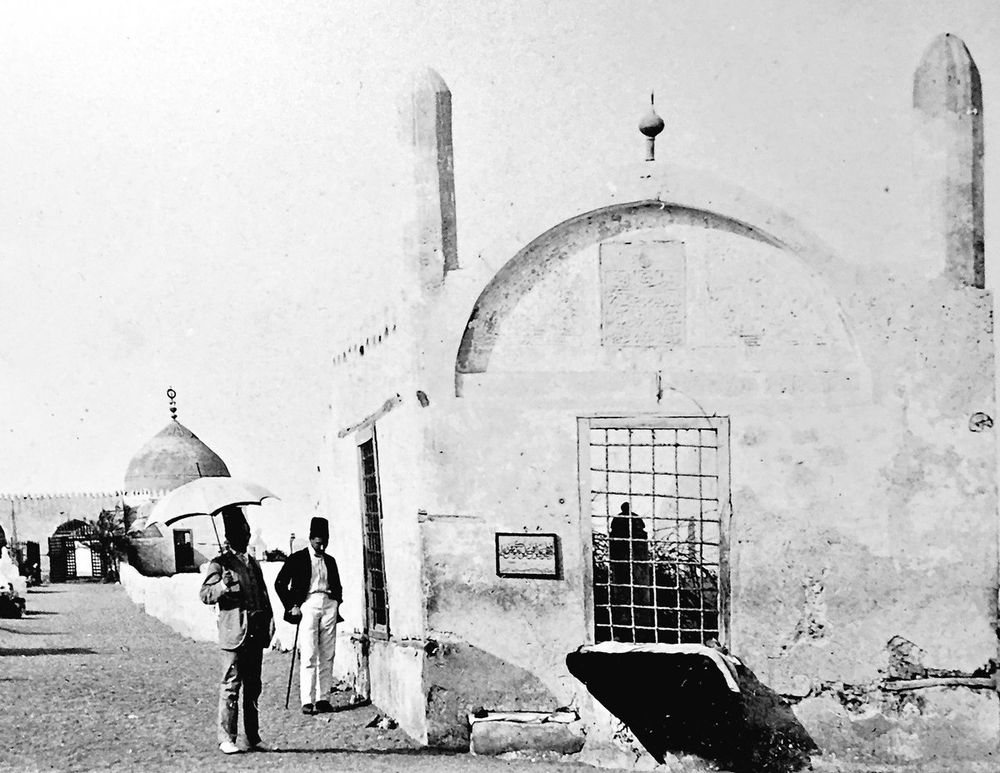Did you know that Eve, that same Biblical Eve whom God supposedly created out of Adam’s rib, remains buried in Jeddah, Saudi Arabia?
Some Muslims believe so. They claim that the city’s name comes from Jaddah, which is an Arabic word meaning grandmother—a reference to Eve, the ‘grandmother of everyone’.

The alleged tomb of Eve in Jeddah. Photo: George Richards
The Quran, like the Bible and the Torah, tells the story of Adam and Eve and how they were expelled from Paradise after disobeying God by eating the forbidden fruit. The Bible doesn’t mention where they ended up on earth, but according to Arab tradition, it is believed that Adam and Eve led separate lives. Adam was exiled to Mecca, where God ordered him to build the Kaaba, the sacred black rock that Muslims around the world face during their five daily prayers. Eve was sent away to Jeddah, where she lived the rest of her life and was buried there.
“There is no definite way of knowing where exactly the tomb is, as some say it is somewhere in Palestine and others say it in Saudi Arabia, who knows," said Frauke Heard-Bey, a German-British historian.
Also read: The Tomb of Jesus Christ in Japan
The earliest documented mention of Eve’s tomb (or the Tomb of Hawa) is by the Arab historian and cartographer Muhammad al-Idrisi in the mid-12th century. Later, Ibn Jubayr, writing in the late 12th century, states that in Jeddah there is a place with an ancient and lofty dome, which is said to have been the lodging place of Eve. Historians Ibn Al-Mujawir and Ibn Khallikan (both from 13th century) makes clear reference to the Tomb of Eve in Jeddah, but famous traveler Ibn Battuta (14th century) never mentioned it when he visited Mecca. Historians like Tabari, Masudi, and others also state that, according to tradition, Eve is buried in Jeddah, but fail to give any detail of her tomb.

Tomb of Eve. Photo: Nawab Sultan Jahan Begam
In 1853, renowned British explorer, geographer and ethnologist Sir Richard Francis Burton visited Eve’s purported tomb disguised as a Muslim pilgrim. Sir Burton said that the tomb was laid out in the shape of a vast reclining body. He measured its length and breadth with his footsteps, and remarked to his guide that “if our first parent measured a hundred and twenty paces from head to waist, and eighty from waist to heel, she must have presented much the appearance of a duck.”
British Acting Consul S. R. Jordan, writing in early 1926, describes the tomb as some 200 yards long and some 4 yards wide, with a small mosque in the middle, where on payment of a few “baksheish”, the keeper of the edifice would lift a flagstone from the center of the floor to allow visitors an opportunity to admire the lady’s navel.
About the Tomb’s contentious dimensions, Indian-Afghan author and publicist Ikbal Ali Shah (1894—1969) said:
Eve must have been a lady of formidable proportions, for the original grave, I was told, was some eight feet long. It was as well, therefore, that she had not survived to welcome us in the flesh, for although it is rumored that we Muslims have an eye for ladies of heroic proportion we draw the line at the titanic. But I was told that the grave had mysteriously extended itself by the time I arrived to its present gigantic proportions.

Tomb of Eve. Photo: Samuel Marinus Zwemer
Awn ar-Rafiq, who served as Emir and Sharif of Mecca from 1882 to 1905, reportedly tried to demolish the tomb, but that caused a public outcry. He then said: “But think you that 'our mother' was so tall? If the stupidity is international, let the tomb stand.”
The tomb eventually did get destroyed in 1928, by Amir Faisal, the 19-year-old Viceroy of the Hejaz and the son of Ibn Saud, Sultan of Nejd and King of the Hejaz. The Time magazine reported how a motor caravan drove all the way from Jeddah to the Sultan’s inland capital, Riyadh, to deliver the “tidings” that “the enlightened son & Viceroy had finally caused to be obliterated that notorious imposture, ‘The Tomb of Mother Eve,’ at Jeddah.”
By 1975 even the ground of Eve’s legendary burial site was sealed in concrete to prevent pilgrims from paying homage or praying there. Today, the cemetery is a row of unmarked tombs, and there’s nothing to indicate Eve’s tomb ever stood there.

Photo: Wikimedia
Despite the absence of any archeological evidence, believers are keen to keep the legend alive. “My mother's grave lies in the same cemetery as that of the mother of all humanity, Hawa," proudly proclaims Sami Nawar, the general director for culture and tourism in Jeddah. Like Nawar, there are hundreds of Saudi families who have relatives buried in Mother Eve’s graveyard.
Sami Angawi, an architect and historian in Saudi Arabia who has been a long-standing critic of the lack of preservations of historic artefacts and monuments, said: “Tombs are not preserved in Saudi Arabia and visiting graves is not encouraged as Wahhabists believe that they could lead to Bedaa [a frowned upon invention that undermines the orthodoxy of Islam] and eventually to shirk.”
Mr Angawi said that over the past 80 years, historic artefacts and sites have been cleared off because of the strict Wahhabi doctrine and for the sake of expansion for the pilgrims whose numbers are increasing each year.
"Eve's tomb is now just a flat hole among a graveyard of unmarked tombs," he said. "It was left to deteriorate, and all we have left is the legend, which will live on and be passed on to the next generations.”
References:
# In unmarked Saudi tomb lies 'grandmother of everyone', The National
# Richard F. Burton, Personal Narrative of a Pilgrimage to Al-Madinah and Meccah
# Arabia:- Jeddah Situation Reports, Qatar Digital Library
# ARABIA: Tomb of Eve, Time












Comments
Post a Comment